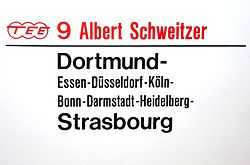Albert Schweitzer (train)
| Albert Schweitzer | |||||
|---|---|---|---|---|---|
 | |||||
| Overview | |||||
| Service type | Trans Europ Express (TEE) | ||||
| Status | Discontinued | ||||
| Locale |
Germany France | ||||
| First service | 2 June 1980 | ||||
| Last service | 27 May 1983 | ||||
| Former operator(s) |
Deutsche Bundesbahn (DB) SNCF | ||||
| Route | |||||
| Start | Dortmund Hbf | ||||
| Stops | 12 | ||||
| End | Strasbourg-Ville | ||||
| Service frequency | Daily, Monday to Friday | ||||
| Train number(s) | TEE 8, 9 | ||||
| On-board services | |||||
| Class(es) | First class only | ||||
| Catering facilities | Restaurant car | ||||
| Technical | |||||
| Track gauge | 1,435 mm (4 ft 8 1⁄2 in) | ||||
| Electrification |
15 kV AC, 16.7 Hz (Germany) | ||||
| |||||
The Albert Schweitzer was a short-lived express train that linked Dortmund Hbf in Dortmund, Germany, with Strasbourg-Ville in Strasbourg, France. Introduced in 1980,[1] it was operated by the Deutsche Bundesbahn (DB) and the SNCF.
The train was named after Albert Schweitzer (1875–1965), a German and then French theologian, organist, philosopher, physician, and medical missionary, who was born in the province of Alsace-Lorraine and educated partly in Strasbourg.
The Albert Schweitzer was a first-class-only Trans Europ Express (TEE) and operated on Mondays to Fridays only. It was intended mainly to provide transport between Bonn, then the capital of West Germany, and the European Parliament in Strasbourg. It was discontinued in 1983.[2]
Route and timetable
- Dortmund Hbf – Essen – Düsseldorf – Cologne (Köln) – Bonn – Darmstadt – Heidelberg – Karlsruhe – Strasbourg-Ville
The southbound train (TEE 9) was scheduled to depart from Dortmund at 6:35 and arrive in Strasbourg at 11:48. The northbound train (TEE 8) was scheduled to leave Strasbourg at 16:43 and reach Dortmund at 21:52.
Formation (consist)
The train's coaches were all from German Federal Railways (DB) and included a separate restaurant car, operated by the German Sleeper and Dining Car Company (in German: Deutsche Schlafwagen- und Speisewagen-Gesellschaft, or DSG).[1] Throughout its route, the train was hauled by electric locomotives,[1] from DB within Germany and from SNCF within France.
EC Albert Schweitzer
In June 2001, a EuroCity service was introduced with the name Albert Schweitzer, linking Frankfurt with Lyon via Strasbourg.[3] In late 2002, the route was altered at its east end to originate and terminate in Stuttgart instead of Frankfurt. The EC Albert Schweitzer was still serving this route, Stuttgart – Strasbourg – Lyon (and vice versa), in summer 2003,[4] but in September 2003 SNCF discontinued use of train names generally,[5] and this EC service became unnamed.
See also
- History of rail transport in France
- History of rail transport in Germany
- List of named passenger trains of Europe
References
Notes
- ↑ 1.0 1.1 1.2 Thomas Cook International Timetable (March 1–April 5, 1980 edition), pp. 66–67, 556. Peterborough, UK: Thomas Cook Publishing.
- ↑ Thomas Cook Continental Timetable (May 29–June 30, 1983 edition), p. 6.
- ↑ "Summer services from June 10" (changes taking effect). Thomas Cook European Timetable (May 2001 edition), p. 532; also p. 550. Thomas Cook Publishing.
- ↑ Thomas Cook European Timetable (May 2003 edition), pp. 73, 229, 232, 437, 565.
- ↑ "What's new this month". Thomas Cook European Timetable (September 2003 edition), p. 3.
Bibliography
- Goette, Peter (2008). TEE-Züge in Deutschland [TEE Trains in Germany]. Freiburg i.B.: EK-Verlag. ISBN 978-3-88255-698-8. (German)
- Malaspina, Jean-Pierre; Mertens, Maurice (2007). TEE: la légende des Trans-Europ-Express [TEE: The Legend of the Trans Europ Express]. Auray: LR Presse. ISBN 978-29-03651-45-9. (French)
- Malaspina, Jean-Pierre; Mertens, Maurice (2008). TEE: la leggenda dei Trans-Europ-Express [TEE: The Legend of the Trans Europ Express]. Salò: ETR – Editrice Trasporti su Rotaie. ISBN 978-88-85068-31-5. (Italian)
- Mertens, Maurice; Malaspina, Jean-Pierre; von Mitzlaff, Berndt (2009). TEE - Die Geschichte des Trans-Europ-Express [TEE - The History of the Trans Europ Express]. Düsseldorf: Alba Publikation. ISBN 978-3-87094-199-4. (German)

